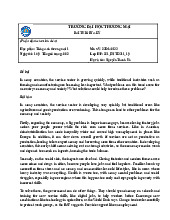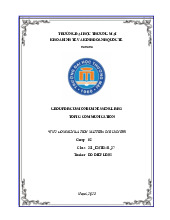













Preview text:
BỘ GIÁO DỤC VÀ ĐÀO TẠO
TRƯỜNG ĐẠI HỌC THƯƠNG MẠI ----- ----- BÀI THẢO LUẬN
HỌC PHẦN: Tiếng Anh Thương Mại 1 ĐỀ TÀI:
The Economics of Renewable Energy Costs and Benefits.
Giảng viên hướng dẫn : Phạm Thị Hồng Quế Lớp học phần
: 242 _ENTI3311_ 27 Nhóm thực hiện : Nhóm 03 lOMoAR cPSD| 46342576 INTRODUCTION
During the process of conducting this discussion, we have received invaluable support, guidance,
and constructive feedback from many individuals, which has helped us achieve the results we have today.
First and foremost, our group would like to express our deepest gratitude to our instructor, Pham
Thi Hong Que from Thuongmai University, who has directly taught, enthusiastically guided, and
shared her valuable experience with us throughout our research. Her support has been instrumental
in helping us complete this discussion smoothly.
Despite our best efforts, our research is not without shortcomings. We sincerely welcome any
feedback, comments, and evaluations from our instructor and peers to further improve our
knowledge and experience for future endeavors. Thank you very much! 2 lOMoAR cPSD| 46342576 Table of Contents
Chapter 1: Key Concepts .......................................................................................................... 3
1.1. Definition of renewable energy ...................................................................................... 3
1.2. Differences between renewable and non-renewable energy sources ............................ 3
1.3. Economic principles related to energy (supply, demand, and externalities) ................. 4
1.4. Importance of transitioning to renewable energy .......................................................... 4
Chapter 2: Types of Renewable Energy .................................................................................. 5
2.1. Solar Energy ................................................................................................................... 5
2.2. Wind Energy ................................................................................................................... 5
2.3. Hydropower .................................................................................................................... 5
2.4. Biomass and Geothermal Energy ................................................................................... 6
Chapter 3: Costs and Benefits .................................................................................................. 7
3.1. Costs of Renewable Energy ............................................................................................. 7
3.2. Benefits of Renewable Energy ........................................................................................ 8
Chapter 4: Challenges and Solutions ..................................................................................... 10
4.1 Key Challenges ............................................................................................................... 10
4.2. Proposed Solutions ....................................................................................................... 11
Chapter 1: Key Concepts
1.1. Definition of renewable energy
There are renewable energy sources that replenish faster than they're consumed, making them
sustainable. Key features include natural replenishment, sustainability, and generally lower
environmental impact compared to fossil fuels. Examples: solar, wind, hydro, geothermal, biomass.
1.2. Differences between renewable and non-renewable energy sources
Renewable energy is naturally replenished, making it sustainable and less polluting than
traditional sources. Its availability depends on geographic conditions, and while initial costs can be
high, long-term operation is often cheaper. Common types include solar, wind, hydro, geothermal,
and biomass, each with unique benefits for energy production.
Non-renewable energy comes from finite resources, making depletion inevitable and
unsustainable. It produces high emissions, contributing to pollution and climate change. These
resources are concentrated in specific regions, leading to geopolitical challenges. While initial costs 3 lOMoAR cPSD| 46342576
are low, operating costs can be volatile. Common types include coal, oil, natural gas, and nuclear energy.
1.3. Economic principles related to energy (supply, demand, and externalities)
Understanding the economics of energy requires applying fundamental principles:
Supply and Demand: The price of energy is determined by the interaction of supply and demand.
Factors influencing supply include resource availability, technology, and production costs.
Demand is driven by economic activity, population growth, and energy efficiency. Externalities:
Energy production and consumption often generate externalities, costs or benefits that are not
reflected in the market price. Negative externalities associated with fossil fuels include air and
water pollution, climate change, and health problems. Renewable energy sources generally have fewer negative externalities.
1.4. Importance of transitioning to renewable energy
The transition to renewable energy is crucial for several reasons:
Environmental Protection: Mitigating climate change and reducing air and water pollution are paramount.
Energy Security: Reducing dependence on volatile global fossil fuel markets enhances national energy security.
Economic Growth: Investing in renewable energy creates jobs, stimulates technological
innovation, and fosters economic diversification.
Public Health: Reducing air pollution improves public health outcomes.
Resource Sustainability: Ensuring long-term access to energy resources for future generations. 4 lOMoAR cPSD| 46342576
Chapter 2: Types of Renewable Energy
2.1. Solar Energy.
Solar energy is one of the most abundant and widely used renewable energy sources. It captures
sunlight and transforms it into electricity via solar panels or thermal systems. One of its biggest
advantages is that it provides a clean and sustainable energy supply with minimal environmental
impact. Additionally, solar power has low operating costs once the system is installed. However,
there are some challenges, such as high initial installation costs, reliance on sunlight, and the
requirement of large areas to maximize energy production. Despite these limitations, ongoing
technological advancements, such as more efficient photovoltaic cells and improved battery
storage, are helping to overcome these challenges and make solar energy more accessible and cost- effective worldwide.
2.2. Wind Energy
Wind energy, which converts wind into electricity using wind turbines, is an alternative renewable-
energy source. It is an efficient and environmentally friendly solution, especially in regions with
strong and consistent winds. Wind power offers numerous benefits, including sustainability, low
maintenance costs, and reduced dependence on fossil fuels. However, it is not without drawbacks.
Wind energy production is inconsistent, as it depends on wind availability. Additionally, wind
turbines can generate noise pollution, pose risks to wildlife, and require significant upfront
investments for large-scale projects. Despite these concerns, offshore wind farms, advancements
in turbine technology, and improved grid integration strategies are making wind power an
increasingly viable and essential part of the global energy mix. 2.3. Hydropower
Hydropower, or hydroelectric energy, generates electricity by utilizing the movement of water to
spin turbines. This energy source is highly reliable because water flow can be controlled to ensure
a continuous supply of power. Hydropower also plays a crucial role in water management, helping
to regulate supply and prevent floods. Despite these benefits, hydropower has its challenges.
Constructing hydroelectric dams is expensive and can have serious environmental consequences,
such as disrupting aquatic ecosystems and displacing local communities. Additionally, droughts
and changing rainfall patterns due to climate change can impact energy generation. To address
these concerns, newer approaches, such as small-scale and run-of-the-river hydropower projects,
are being developed to minimize environmental disruption while still providing clean energy. 5 lOMoAR cPSD| 46342576
2.4. Biomass and Geothermal Energy
Biomass and geothermal energy are also important renewable energy options. Biomass energy is
produced from organic materials, such as wood, crops, and waste, while geothermal energy taps
into heat stored within the Earth. Biomass energy contributes to waste reduction and promotes a
circular economy, making it a sustainable alternative to fossil fuels. On the other hand, geothermal
energy provides a stable and continuous energy supply, unaffected by weather conditions.
However, both sources have limitations. Biomass energy production can lead to deforestation and
air pollution if not managed properly. Geothermal energy, while highly efficient, requires specific
geological conditions and significant initial investments. Continued innovation in biomass
conversion technology and enhanced geothermal systems (EGS) are improving efficiency and
sustainability, making these energy sources more attractive for widespread adoption. 6 lOMoAR cPSD| 46342576
Chapter 3: Costs and Benefits
3.1. Costs of Renewable Energy.
a) Initial Investment and Infrastructure.
The first and most significant cost of renewable energy is the initial investment required to set up
the infrastructure. Renewable energy technologies such as solar panels, wind turbines, and
hydropower plants require significant upfront capital for installation. For instance, a solar farm can
cost anywhere between $1 million and $3 million per megawatt of installed capacity, and a wind
turbine installation can cost $1.3 million to $2.6 million per turbine, depending on the location and
scale of the project. This is substantially higher than the cost of establishing fossil fuel power plants.
Moreover, the infrastructure needed to support renewable energy generation, including
transmission lines, substations, and storage systems, can also add considerable costs. To connect
renewable energy plants to the grid, new transmission lines might need to be built, which is both
time-consuming and expensive. In some cases, the need for advanced grid infrastructure to support
renewable energy systems further escalates costs, as the electricity grid needs to be upgraded to
handle the fluctuations in renewable energy supply. b) Storage and Grid Integration Challenges
A major issue with renewable energy is its intermittency—solar and wind power generation
depends on weather conditions and is not constant. Therefore, energy storage systems are necessary
to store excess energy produced during periods of high generation for use when demand is high,
and supply is low. The most common forms of storage are batteries, such as lithium-ion, or other
methods like pumped hydro storage. However, energy storage technologies are expensive, and
large-scale battery systems are still relatively new and costly.
Additionally, grid integration remains a challenge. Most grids were designed to support a stable,
continuous flow of energy from centralized power plants, usually fueled by coal, gas, or nuclear
power. The integration of renewable energy requires a more dynamic and flexible grid system that
can manage variable electricity supply and demand. This may involve significant investment in
grid infrastructure, including smart grid technology, which allows better management and
distribution of electricity from renewable sources. Therefore, the costs involved in integrating
renewables into existing grid systems can be substantial. c) Maintenance and Operational Expenses
While renewable energy systems are generally less expensive to operate than fossil fuel plants,
there are still maintenance and operational costs involved. Wind turbines require regular
inspections, lubrication, and occasionally replacing parts like blades and gearboxes. Solar panels 7 lOMoAR cPSD| 46342576
need to be kept clean and periodically checked for faults to maintain high efficiency. Hydropower
plants also have maintenance needs, such as ensuring that turbines and dams remain in optimal working condition.
Though maintenance costs for renewable energy systems are lower than for conventional power
plants, they still represent a recurring financial commitment. For example, maintaining a wind
turbine typically costs around 1.5 to 2 percent of the capital investment per year, while solar panels
cost less but still require some attention to remain efficient.
3.2. Benefits of Renewable Energy.
a) Long-term Cost Savings.
One of the key benefits of renewable energy is the long-term cost savings it offers. While the initial
investment is high, renewable energy technologies have low operational and fuel costs once
installed. Solar and wind energy, for instance, do not require purchasing fuel, unlike fossil fuel-
based power plants. Over time, this leads to significant savings. According to research, the levelized
cost of electricity (LCOE) for solar and wind has fallen drastically in recent years, making them
more competitive with traditional energy sources.
For example, the cost of solar power has decreased by more than 70% in the past decade, making
it one of the cheapest forms of new electricity generation in many parts of the world. Once the
infrastructure is set up, the cost of generating renewable energy is much lower than maintaining
fossil fuel plants, as they do not rely on the ongoing expense of purchasing coal, gas, or oil. b)
Environmental Protection and Emission Reduction.
Another substantial benefit of renewable energy is its positive impact on the environment. Unlike
fossil fuel-based energy, which emits harmful pollutants and greenhouse gases (GHGs), renewable
energy sources such as solar, wind, and hydroelectric power produce zero or minimal emissions
during operation. By switching to renewable energy, countries can significantly reduce their carbon
footprint, which helps combat climate change and air pollution.
For instance, solar energy produces no air pollution or greenhouse gases during its operation. Wind
energy is also emissions-free, and hydropower significantly reduces GHGs compared to coal-fired
power generation. The widespread adoption of renewable energy could reduce global emissions by
up to 70% by 2050, which would have a major impact on limiting global warming. c) Job Creation
and Energy Independence. 8 lOMoAR cPSD| 46342576
Renewable energy also brings important economic benefits, particularly in terms of job creation
and energy independence. The renewable energy sector is labor-intensive, requiring workers for
manufacturing, installation, operation, and maintenance of energy systems. According to the
International Renewable Energy Agency (IRENA), global employment in renewable energy grew
by more than 11% in recent years, with millions of jobs being created worldwide.
Furthermore, renewable energy can help reduce reliance on imported fossil fuels, promoting energy
independence. Countries that depend heavily on oil, coal, and gas imports are vulnerable to price
volatility and supply disruptions. By investing in local renewable energy resources, nations can
diversify their energy mix and increase energy security. For instance, wind and solar power can be
harnessed locally, reducing a nation's reliance on foreign energy sources and improving economic stability. 9 lOMoAR cPSD| 46342576
Chapter 4: Challenges and Solutions
4.1 Key Challenges 4.1.1 For Businesses: a)
High upfront capital investment: One of the major barriers businesses face when
transitioning to renewable energy is the significant initial investment. The cost of purchasing and
installing renewable energy infrastructure—like solar panels, wind turbines, or energy storage
systems— can be very high. This upfront cost can be difficult to manage, especially for small or mediumsized enterprises. b)
Intermittency and energy storage: Renewable energy sources like solar and wind can be
intermittent, meaning they don’t produce energy all the time. For instance, solar panels generate
energy only when the sun is shining, and wind turbines only work when there’s wind. Businesses
must invest in energy storage solutions to manage this issue, ensuring they can access power even
when renewable sources are not producing. c)
Market competition with fossil fuels: Fossil fuels still dominate the global energy market
and businesses that switch to renewable energy may find themselves at a competitive disadvantage.
Fossil fuel-based energy is often cheaper in the short term, and renewable energy may not always
be as cost-competitive, especially without government subsidies or tax incentives. Overcoming
this price gap is a major challenge for businesses looking to adopt cleaner energy sources. 4.1.2 For Governments: a)
Policy and regulatory barriers: Governments face the challenge of establishing supportive
policies and regulations for renewable energy adoption. In many countries, existing laws, subsidies,
and policies assist fossil fuels. Transitioning away from these entrenched systems can be politically
and socially challenging. Governments need to create incentives and subsidies for renewable
energy while phasing out fossil fuel subsidies to ensure a fair competitive environment. b)
Infrastructure and grid modernization: Renewable energy sources often require a
modernization of the electrical grid. Many existing grids were built around centralized fossil fuel
plants and may not be suited for decentralized renewable energy generation. To fully integrate
renewables, governments need to invest in modernizing infrastructure, improving grid resilience,
and enabling better energy storage and distribution. This can be a significant financial and logistical challenge. c)
Public perception and resistance to change: Public perception of renewable energy can be
another major difficulty for governments. There may be resistance from people who are either 10 lOMoAR cPSD| 46342576
misinformed about the benefits of renewables or who fear job losses in traditional industries like
coal and oil. Overcoming this resistance requires education, awareness campaigns, and policies
that demonstrate the long-term benefits of renewable energy, such as job creation in new green
industries and the environmental advantages.
4.2. Proposed Solutions 4.2.1. For Businesses:
a) Investment in Research and Development (R&D): Increase funding for clean technologies such
as energy storage batteries, green hydrogen production, and recyclable materials. Encourage
collaboration with research institutes and universities to drive innovation. Apply artificial
intelligence (AI) and big data to optimize energy usage.
b) Public-Private Partnerships for Funding: Foster cooperation between governments and
businesses to develop renewable energy projects. Establish green investment funds to support
startups and small & medium enterprises (SMEs) in the sustainable energy sector. Improve
green financing mechanisms, such as issuing green bonds or providing preferential credit for
businesses adopting sustainable technologies.
c) Adoption of Hybrid Energy Solutions: Integrate multiple renewable energy sources such as
solar, wind, and hydropower to ensure a stable energy supply. Deploy microgrid systems to
optimize energy use in industrial zones and commercial buildings. Apply advanced energy
storage technologies such as next-generation lithium-ion batteries or hydrogen fuel cells. 4.2.2.For Governments:
a) Subsidies and Incentives for Renewable Energy: Offer tax exemptions for businesses investing
in clean energy. Provide financial support for households installing solar and wind energy
systems. Implement "feed-in tariff" models to encourage electricity generation from renewable sources.
b) Strengthening Policies and Carbon Pricing: Enforce strict carbon emission regulations for
heavy industries. Implement carbon trading systems to control greenhouse gas emissions.
Introduce mandatory energy efficiency standards across transportation, construction, and manufacturing sectors.
c) Developing Smart Grids and Energy Storage Solutions: Invest in smart grid infrastructure to
enhance energy efficiency and reduce power losses. Support research and deployment of large-
scale energy storage technologies such as sodium-ion batteries, solid-state batteries, and 11 lOMoAR cPSD| 46342576
thermal storage solutions. Encourage the adoption of advanced energy management systems in
urban areas and industrial zones. 12 lOMoAR cPSD| 46342576 FOREWORD
Renewable energy is playing an increasingly vital role in the global economy as countries seek
sustainable alternatives to fossil fuels. The transition to renewable sources, such as solar, wind, and
hydro power, offers significant environmental and economic advantages, including reduced
greenhouse gas emissions, energy security, and job creation. However, this shift also comes with
financial challenges, such as high initial investment costs, infrastructure requirements, and market
competition with conventional energy sources.
This discussion aims to explore the economic aspects of renewable energy, focusing on both costs
and benefits. Key topics include capital investment, operational expenses, long-term economic
returns, government policies, and the impact on labor markets. By analyzing these factors, we can
gain a deeper understanding of the opportunities and obstacles associated with renewable energy adoption.
Through this discussion, we hope to highlight the economic feasibility of renewable energy and
its potential to drive sustainable growth while addressing financial and policy-related challenges. 13 lOMoAR cPSD| 46342576 CONCLUSION
The economics of renewable energy present a compelling case for a sustainable and costeffective
energy future. While initial investment costs can be high, the long-term benefitsincluding lower
operational costs, reduced dependence on fossil fuels, and significant environmental advantages-
outweigh these challenges. Advances in technology, government policies, and market dynamics are
driving down costs and improving efficiency, making renewable energy increasingly competitive
with traditional energy sources. As the world transitions toward a low-carbon economy, investing
in renewable energy is not only an environmental necessity but also a strategic economic decision
that fosters growth, innovation, and energy security. 14




